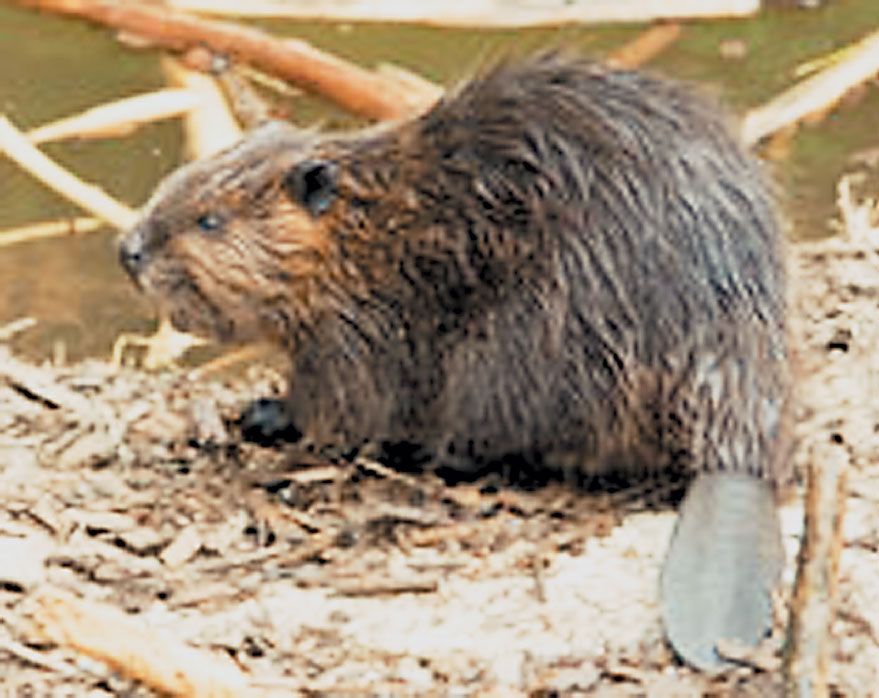A task that’s flat-out perfect for beavers
Published 5:27 pm Friday, December 9, 2011

- A group including Suzanne Fouty of Baker City is lobbying President Joe Biden to sign an executive order banning beaver trapping on federal land. They say beavers, by building dams that store water and raise the water table, can help combat the harmful effects of drought and climate change.
By JAYSON JACOBY
Trending
jjacoby@bakercityherald.com
The Whitman Ranger District has laid out a big job, and one that’s tailor-made for beavers.
But first the district has to entice these industrious, but relatively finicky, rodents to the work site.
Trending
In theory, attracting beavers is pretty simple.
What you need, mainly, are water and trees.
Deciduous trees, in particular – aspen, cottonwoods and willows being among beavers’ favorite species.
Leafy trees lure beavers in the way candy calls in kids.
Except beavers not only enjoy munching on trees.
The animals also use trees as the building material for their dams.
Beavers – and specifically those dams – can confer considerable
benefits on streams and the surrounding land, said Fouty, who is the
hydrologist for the Whitman Ranger District and developed the beaver
project.
Streams with a stable network of beaver dams and ponds tend to flow
more reliably, being less susceptible to the boom-bust cycle of spring
flood and summer drought that’s common in beaver-deficient creeks in
Eastern Oregon.
Other laudable effects, Fouty said, could include:
andbull; Lowering water temperatures, a boon for trout and other fish
andbull; Raising the water table
andbull; Widening the zone of lush streamside vegetation that’s valuable habitat for wildlife as well as domestic livestock
“Beavers are a tool, and one with huge potential to improve stream
conditions,” Fouty said. “Basically you let the beavers do the work.”
And beavers, unlike engineers and construction crews, don’t draw a salary.
Beavers were once nearly ubiquitous along local waterways – not for
nothing is Oregon’s nickname “the Beaver state” and its state animal
the beaver.
(And a beloved mascot, as alumni of Oregon State University can attest.)
But 19th century trappers – and the East Coast fashion mavens who
bought their wares – coveted beavers for their thick, luxurious pelts,
and by the turn of the 20th century beavers had nearly been extirpated
from the state.
Beaver numbers have rebounded in Oregon over the past several decades.
But the deleterious effects of their absence persist in many streams,
including the site of the long-term project Fouty is excited about: the
North Fork of Burnt River in southwestern Baker County.
The North Fork, along with tributaries such as Camp, Gimlet and Pinus
creeks, tend to run high and muddy during the spring runoff, then
dwindle to mere trickles by late summer.
Or go dry altogether, in the case of Gimlet and Pinus creeks.
The North Fork and Camp Creek are on a federal list of streams that
don’t meet water quality standards – the North Fork for high water
temperatures during summer, and both streams due to excessive
sedimentation.
Gimlet and Pinus creeks are both tributaries of Camp Creek, which in
turn empties into the North Fork in Whitney Valley, about 40 miles
southwest of Baker City.
“I’m always looking for restoration chances, and the North Fork has characteristics that make it ideal for beavers,” Fouty said.
One advantage of the North Fork and its tributaries is that they’re relatively flat streams, she said.
Beaver generally avoid creeks in steep terrain because the faster water flow is more likely to dislodge their dams.
The near-eradication of beavers isn’t the only culprit in the condition of the North Fork and its tributaries, Fouty said.
The combination of intensive placer mining, road-building, livestock
grazing, and efforts to confine streams to straight channels to
maximize pasture acreage also has contributed to the current situation.
Besides being prone to spring flood and summer drought, the streams are
deficient in shade trees, and they have steep, tall banks that prevent
water from spreading away from the channel and restoring groundwater
supplies.
Putting beavers to work restoring the streams is not a new idea.
The Oregon Department of Fish and Wildlife transplanted beavers to the North Fork in the 1990s.
Although beavers remain in the area, there are too few animals to have
the effects that the Wallowa-Whitman and its partner, the Powder Basin
Watershed Council, envision.
(There are no plans to bring in any more beavers, Fouty said.)
The underlying problem, Fouty said, is a lack of healthy streamside thickets of aspen and other deciduous trees.
Without that, she said, beavers are more likely to pass through than to stay.
“These streams have pockets of riparian vegetation, but not enough to sustain a number of beaver dams,” Fouty said.
Reversing that trend is the goal of the Forest Service/Watershed
Council project, which over the past two years has spent about $115,000
($67,000 from the Forest Service; $47,000 from the Oregon Watershed
Enhancement Board; $1,400 from the Oregon Department of Fish and
Wildlife).
Students from Whitman College in Walla Walla, Wash., have contributed
labor – planting trees and doing surveys to establish baseline
conditions for the area – worth an estimated $29,000.
The project has three main parts:
andbull; Reducing conifer competition around aspen groves.
Pine and fir trees will gradually suppress aspen by casting shade over
the sun-loving aspen, and by soaking up limited supplies of water and
soil nutrients.
andbull; Building wooden fences around aspen groves to keep wildlife (elk in particular) and cattle from gobbling aspen seedlings.
andbull; Planting willows along streams.
Fouty concedes that aspects of this strategy might seem counterintuitive.
“We’re basically trying to save trees so beaver can come in and cut them down,” she said.
But that’s not as illogical as it might sound.
The objective, she said, is to reach a balance in which there is a
self-sustaining population of trees that’s also sufficient to meet
beavers’ needs for food and dam-building material.
Also, beaver mainly take down older, larger trees.
This provokes aspen to put out thousands of seedlings, known as
“suckers” (an aspen grove might consists of several “parent” trees,
each of which produces dozens or hundreds or genetically identical
clones).
Elk and cattle, by contrast, tend to eat the suckers, and in the case of elk, the bark of older trees.
In heavily browsed groves, there might be only very old aspen trees
towering over mats of trees that never grow taller than two or three
feet because they’re chewed to the stem every year, Fouty said.
The Forest Service itself must shoulder some of the blame for the decline in aspen.
The agency’s success at putting out wildfires affects aspen groves in two ways, she said.
First, the absence of fire has allowed conifers to encroach.
Second, fire stimulates parent aspens to produce lots of suckers.
Over time, this combination of regular browsing and irregular fire
prevents aspen groves from replacing parent trees that die from old age
or are toppled by wind.
To avoid that fate for some of the larger groves in the North Fork
area, Forest Service crews earlier this year built a trio of fences –
one along lower Gimlet Creek that encompassed 7.7 acres, a 1.4-acre
area along upper Gimlet Creek, and 1.6 acres along an unnamed tributary
to Camp Creek.
Fouty said two more fences, enclosing about two acres each, will be built in 2012 along Pinus Creek.
Crews have already removed conifer trees that were crowding several aspen groves.
As for the third tactic, the Forest Service in 2009 planted 5,200
willows along a 1.7-mile reach of Camp Creek, and in 2010, Whitman
students planted several hundred willows along Gimlet Creek.
More planting is planned for 2012.
Besides serving as a source of food and dam-building material for
beavers, the willows shade the streams, lowering the temperature, and
their roots stabilize the banks.
Fouty acknowledges that a burgeoning beaver population can lead to problems as well as benefits.
Beaver dams can plug culverts, leading to road washouts, they can
damage irrigation ditches, and the rising water table can inundate
streamside campsites.
But she points out that there are proven techniques for dealing with
such problems – a device known as a “beaver deceiver,” for instance,
can control the level of a pond and prevent localized flooding, or
discourage the animals by continually draining the pond behind a dam.
Ultimately, Fouty said, the presence of beavers has the potential to
help farmers and ranchers who depend on streams for irrigation.
Unlike manmade structures, beaver dams constantly leak, so even a stream with several dams will always flow.
Moreover, by temporarily storing water, and thus raising the water
table, a stream with plentiful beaver dams tends to maintain a higher
flow in summer and early fall than an undammed stream.
Jerry Franke, who manages the Burnt River Irrigation District, which is
downstream from the Forest Service/Watershed Council project, supports
the effort – with one major condition.
“I’m all for it, as long as they keep (beavers) off agricultural ground,” Franke said.
The relatively low volume of the North Fork’s tributaries mean that
even if the project fulfills its goals, the benefit to irrigators who
get water from Unity Reservoir (which collects the combined flow of the
Burnt River’s North, Middle and South forks) is likely to be so small
that it’s difficult to measure, Franke said.
Nonetheless, he said the basic idea – first improving habitat to
attract beavers, then dealing with any side effects the animals have –
is sound.
“I think the concept, in the right place, is good,” Franke said. “I like the experiment. It’ll be interesting to watch.”
Fouty emphasizes that the North Fork project probably won’t yield
significant gains in water supply immediately, or even, perhaps, in
five years.
But she said it’s plausible that within, say, 10 to 15 years, the
changes wrought by beavers on the North Fork’s tributaries will have
noticeable effects on the river itself, especially during late summer.
This year, for instance, the North Fork, which flowed at a volume of
410 cubic feet per second (cfs) on May 19, dipped to 48 cfs by June 22,
and to 1.6 cfs at the end of August.
Fouty is optimistic, too, that Gimlet Creek, once enriched with beaver dams, will flow year-round.
And if the beaver experiment bears fruit on that and the two other
tributaries, and beavers expand into other tributaries, the North
Fork’s spring floods could be tamed enough that beaver can build dams
on the North Fork itself, a much larger waterway.
In any case, she’s eager to watch, and measure, the progress.
Besides being a beaver-friendly area, the North Fork, with its
proximity to Highway 7 and well-maintained Forest Service roads, is
easily accessible both for Fouty and other scientists, as well as the
public.
“It’s a great laboratory,” she said.









